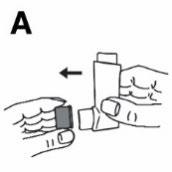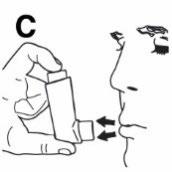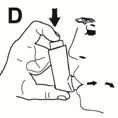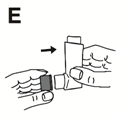
Veriflo
Ask a doctor about a prescription for Veriflo

How to use Veriflo
Leaflet accompanying the packaging: patient information
Veriflo, (25 micrograms + 50 micrograms)/metered dose, inhalation aerosol,
suspension
Veriflo, (25 micrograms + 125 micrograms)/metered dose, inhalation aerosol, suspension
Veriflo, (25 micrograms + 250 micrograms)/metered dose, inhalation aerosol, suspension
Salmeterol + Fluticasone propionate
You should carefully read the contents of the leaflet before using the medicine, as it contains important information for the patient.
- You should keep this leaflet, so that you can read it again if necessary.
- In case of any doubts, you should consult a doctor, pharmacist, or nurse.
- This medicine has been prescribed to a specific person. It should not be given to others. The medicine may harm another person, even if the symptoms of their illness are the same.
- If the patient experiences any side effects, including any side effects not listed in this leaflet, they should tell their doctor, pharmacist, or nurse. See section 4.
Table of contents of the leaflet
- 1. What is Veriflo and what is it used for
- 2. Important information before using Veriflo
- 3. How to use Veriflo
- 4. Possible side effects
- 5. How to store Veriflo
- 6. Contents of the packaging and other information
1. What is Veriflo and what is it used for
Veriflo contains two active substances: salmeterol and fluticasone propionate.
- Salmeterol is a long-acting bronchodilator. Bronchodilators help maintain the patency of the airways. This facilitates the flow of air to and from the lungs. The effect lasts for at least 12 hours.
- Fluticasone propionate is a corticosteroid that reduces swelling and irritation of the lungs.
The doctor has prescribed this medicine to the patient to prevent breathing disorders that occur in asthma. Veriflo must be used every day as recommended by the doctor. This will ensure proper control of asthma.
Veriflo prevents shortness of breath and wheezing in the airways. However, Veriflo should not be used to control sudden attacks of shortness of breath or wheezing in the airways. If such an attack occurs, it is necessary to use a fast-acting bronchodilator, such as salbutamol, immediately. The patient should always have such a medicine with them.
It is very important to always carry a fast-acting bronchodilator with you.
2. Important information before using Veriflo
When not to use Veriflo
- if the patient is allergic to salmeterol, fluticasone propionate, or any of the other ingredients of this medicine (listed in section 6).
Warnings and precautions
Before starting to use Veriflo, the patient should talk to their doctor or pharmacist if they have:
- heart disease, including irregular or rapid heartbeat,
- hyperthyroidism,
- high blood pressure,
- diabetes (Veriflo may increase blood glucose levels),
- low potassium levels in the blood,
- tuberculosis currently being treated or a history of tuberculosis or other lung infections.
If the patient experiences blurred vision or other vision disturbances, they should contact their doctor.
Veriflo and other medicines
The patient should tell their doctor or pharmacist about all medicines they are currently taking, or have recently taken, and about medicines they plan to take, including asthma medicines and medicines that are available without a prescription. This is important because Veriflo should not be used with some other medicines.
Before starting to use Veriflo, the patient should inform their doctor about taking the following medicines:
- Beta-blockers (e.g., atenolol, propranolol, and sotalol). Beta-blockers are most commonly used to treat high blood pressure or other heart diseases.
- Medicines used to treat infections (e.g., ketoconazole, itraconazole, and erythromycin), including some medicines used to treat HIV (e.g., ritonavir, cobicistat-containing products). Some of these medicines may increase the levels of fluticasone propionate or salmeterol in the body. This may increase the risk of side effects of Veriflo, including irregular heartbeat, or may worsen existing side effects. The doctor may want to closely monitor the patient's condition.
- Corticosteroids (orally or by injection). If the patient has recently taken such medicines, it may increase the risk of adrenal gland disorders.
- Diuretics used to treat high blood pressure.
- Other bronchodilators (such as salbutamol).
- Medicines containing xanthine derivatives, often used to treat asthma.
Pregnancy and breastfeeding
If the patient is pregnant or breastfeeding, thinks they may be pregnant, or plans to have a child, they should consult their doctor or pharmacist before using this medicine.
Driving and using machines
It is unlikely that Veriflo will affect the patient's ability to drive or use machines.
3. How to use Veriflo
This medicine should always be used as recommended by the doctor or pharmacist. In case of doubts, the patient should consult their doctor or pharmacist.
- Veriflo should be used every day, unless the doctor recommends otherwise. The patient should not take a higher dose than recommended. In case of doubts, the patient should consult their doctor or pharmacist.
- The patient should not stop using Veriflo or reduce the dose without consulting their doctor.
- Veriflo should be inhaled into the lungs through the mouth. The inhaler is designed for 120 doses. However, it cannot be determined when the inhaler is empty and when 120 puffs have been released. There may still be a small amount of liquid in the container.
The patient should make sure to replace the inhaler after 120 puffs have been released to ensure that they receive the correct amount of medicine in each puff.
Adults and adolescents 12 years and older
- Veriflo (25 micrograms + 50 micrograms)/metered dose - two inhalations twice a day.
- Veriflo (25 micrograms + 125 micrograms)/metered dose - two inhalations twice a day.
- Veriflo (25 micrograms + 250 micrograms)/metered dose - two inhalations twice a day.
Children 4 to 12 years old
- Veriflo (25 micrograms + 50 micrograms)/metered dose - two inhalations twice a day.
- Veriflo is not recommended for use in children under 4 years of age.
Using Veriflo twice a day may help control asthma symptoms. Then, the doctor may recommend reducing the frequency of use to once a day. The dose may be changed and may be given:
- once a day, in the evening, if the patient experiences symptoms at night,
- once a day, in the morning, if the patient experiences symptoms during the day.
It is very important that the doctor instructs the patient on how many inhalations to use and how often. If the patient is using Veriflo for asthma, the doctor will regularly check the patient's symptoms.
If the patient's asthma symptoms worsen or breathing becomes more difficult, they should
contact their doctor immediately.The patient may experience increased wheezing, more frequent chest tightness, or may need to use a higher dose of a fast-acting inhalation medicine to facilitate breathing. In any of these situations, the patient should continue to use Veriflo, but should not increase the number of inhalations. The symptoms of the disease may worsen, and the patient's condition may deteriorate. The patient should contact their doctor, as they may need additional treatment.
Instructions for use
- The doctor, nurse, or pharmacist should instruct the patient on how to use the inhaler. They should periodically check that the patient is using it correctly. Incorrect use of Veriflo or use that is not in accordance with the doctor's recommendation may result in the medicine not producing the expected improvement in asthma.
- The medicine is in a pressurized container in a plastic housing with a mouthpiece.
- A new, full inhaler contains enough medicine for at least 120 doses. After 120 puffs, the inhaler may not have enough medicine to deliver a full dose.
Checking the inhaler:
- 1. Before first use, the patient should check that the inhaler is working. The patient should remove the cap from the mouthpiece by gently pressing the sides of the cap with their thumb and index finger.
- 2. To ensure that the inhaler is working, the patient should shake the container vigorously, move the mouthpiece away from them, and press the container to release a dose of medicine into the air. The patient should repeat this process a second time, shaking the inhaler before releasing the second dose into the air. The patient should release two doses into the air before each use.
- 3. After the first two test sprays, the patient can start using the inhaler.
- 4. If the inhaler has not been used for a week or more, or if the inhaler is very cold (below 0°C), the patient should release two doses of medicine into the air.
Warnings
Never remove the metal container from the inhaler. If the inhaler is very cold (below 0°C), the patient should remove the metal container from the plastic housing and warm it in their hands for a few minutes before use. The patient should never use anything else to heat it. After warming and before use, the patient should press the container firmly to release two sprays into the air.
How to use the inhaler
It is essential to start breathing as slowly as possible just before using the inhaler.





- 1. The inhaler should be used standing or sitting.
- 2. Remove the mouthpiece cap (Figure A)
- 3. Check the mouthpiece outside and inside to ensure it is clean and free of foreign objects.
- 4. Shake the inhaler 4 or 5 times to ensure the contents are well mixed (Figure B).
- 5. Hold the inhaler in an upright position, with the thumb on the base of the inhaler below the mouthpiece. Take a deep breath out, as far as it is comfortable (Figure C).
- 6. Put the mouthpiece in the mouth between the teeth. Close the lips around the mouthpiece. Do not bite the mouthpiece.
- 7. Take a slow, deep breath in through the mouth. Immediately after starting to breathe in, press the top of the container firmly to release the medicine. Continue to breathe in slowly and deeply (Figure D).
- 8. Hold the breath and remove the inhaler from the mouth, and take the finger off the base of the inhaler. Hold the breath for a few seconds or as long as it is comfortable.
- 9. To take another inhalation, the patient should wait about half a minute before repeating the steps described in points 4-8.
- 10. After inhalation, the patient should rinse their mouth with water and spit it out and/or brush their teeth. This may help prevent thrush (fungal infection) of the mouth and throat, as well as hoarseness.
- 11. After inhalation, the patient should always put the cap back on the mouthpiece to prevent dust from entering. The cap should click into place. The patient should not use excessive force.
The patient should not rush through the steps in points 5, 6, 7, and 8. It is very important that patients start breathing as slowly as possible just before using the inhaler. Initially, inhalations should be performed standing in front of a mirror. If a "mist" is seen coming out of the inhaler or from the corners of the mouth during inhalation, the patient should repeat the steps, starting from point 4.
As with other inhalers, caregivers should ensure that children who have been prescribed Veriflo use the correct inhalation technique, as described above. If the patient or child has difficulty using the inhaler, the doctor or another healthcare professional may recommend using the inhaler with a spacer, such as the AeroChamber Plus. The doctor, nurse, or pharmacist, or another healthcare professional, should demonstrate how to use the spacer and how to care for the device, and answer any questions the patient may have. If the patient uses the inhaler with a spacer, it is essential not to stop using it without consulting a doctor or nurse. Other spacers are not recommended for use with Veriflo, and the AeroChamber Plus should not be replaced with another device.It is also essential not to change the type of spacer or stop using it without consulting a doctor, who may decide to change the dose. Before making any changes to asthma treatment, the patient should always talk to their doctor.
Older children or people with less hand strength may find it easier to hold the inhaler with both hands. The patient should place two index fingers on the inhaler and both thumbs on the bottom below the mouthpiece.
Cleaning the inhaler
To prevent the inhaler from becoming blocked, it is essential to clean it at least once a week. To clean the inhaler:
- Remove the cap from the mouthpiece.
- Never remove the metal container from the plastic housing.
- Clean the mouthpiece inside and outside, and the plastic housing outside, with a dry cloth or tissue.
- Put the cap back on the mouthpiece. The cap should click into place. The patient should not use excessive force.
- Do not use excessive force.
- Do not immerse the metal container in water.
Using a higher dose of Veriflo than recommended
It is essential to use the inhaler as instructed. If a higher dose than recommended is used accidentally, the patient should tell their doctor or pharmacist. The patient may experience: a faster than normal heartbeat, tremors, dizziness, headache, weakness, and muscle pain. If higher doses are used for a long time, the patient should consult their doctor or pharmacist. High doses of Veriflo may cause a decrease in the production of steroid hormones by the adrenal glands.
Missing a dose of Veriflo
The patient should not take a double dose of the medicine to make up for a missed dose. The patient should take the next dose at the scheduled time.
Stopping the use of Veriflo
It is very important to take Veriflo every day, as recommended. The patient should take the medicine until their doctor recommends stopping it. The patient should not suddenly stop taking Veriflo or reduce the dose. This may cause more difficulty breathing.
Additionally, sudden stopping or reduction of Veriflo may (very rarely) cause adrenal gland disorders (adrenal insufficiency), which can sometimes cause side effects. These side effects may include:
- Abdominal pain
- Fatigue and loss of appetite, nausea
- Vomiting and diarrhea
- Weight loss
- Headache and drowsiness
- Low blood sugar
- Low blood pressure and seizures (fits).
If the patient experiences any of these side effects, they should tell their doctor or pharmacist. To prevent these symptoms, the doctor may prescribe additional corticosteroids in tablet form (e.g., prednisolone). If the patient experiences any further doubts about using this medicine, they should consult their doctor, nurse, or pharmacist.
4. Possible side effects
Like all medicines, Veriflo can cause side effects, although not everybody gets them. To minimize the risk of side effects, the doctor will prescribe the lowest dose of Veriflo that controls asthma.
Allergic reactions: The patient may experience sudden breathing difficulties immediately after
using Veriflo. The patient may experience increased wheezing, coughing, or shortness of breath, as well as itching, rash (hives), and swelling (usually of the face, lips, tongue, or throat). The patient may also experience a very fast heartbeat, weakness, and dizziness (which can lead to falls or loss of consciousness). If the patient experiences any of these symptoms, including if they occur suddenly after using Veriflo, they should stop using Veriflo and contact their doctor immediately.Allergic reactions to Veriflo are uncommon (they may occur less often than in 1 in 100 people).
Other side effects:
Very common (may affect more than 1 in 10 people)
- Headache - this side effect usually decreases over time as treatment continues.
- Increased frequency of colds has been reported in patients with chronic obstructive pulmonary disease (COPD).
Common (may affect up to 1 in 10 people)
- Thrush (painful, creamy-white patches) in the mouth and throat, as well as sore tongue, hoarseness, and throat irritation. Rinsing the mouth with water and spitting it out and/or brushing the teeth after each inhalation may be helpful. The doctor may prescribe an antifungal medicine to treat thrush.
- Pain, swelling of the joints, and muscle pain.
- Muscle cramps.
The following side effects have been reported in patients with chronic obstructive pulmonary disease (COPD):
- Pneumonia and bronchitis (lung infection). The patient should tell their doctor if they experience any of the following symptoms: increased production of mucus, change in the color of mucus, fever, chills, increased coughing, or increased difficulty breathing.
- Easier bruising and fractures.
- Sinusitis (feeling of tension and fullness in the nose, cheeks, and behind the eyes, sometimes with a throbbing headache).
- Low potassium levels in the blood (the patient may experience irregular heartbeat, muscle weakness, or cramps).
Uncommon (may affect up to 1 in 100 people)
- Increased blood sugar (glucose) levels (hyperglycemia). In patients with diabetes, it may be necessary to monitor blood sugar levels more frequently and adjust the dose of antidiabetic medicines.
- Cataract (clouding of the lens of the eye).
- Very fast heartbeat (tachycardia).
- Feeling of trembling and fast or irregular heartbeat (palpitations) - these symptoms usually are not serious and decrease over time as treatment continues.
- Chest pain.
- Anxiety (this side effect occurs mainly in children).
- Sleep disturbances.
- Allergic skin rash.
Rare (may affect up to 1 in 1000 people)
- Difficulty breathing or wheezing worsening immediately after taking Veriflo.If the patient experiences such symptoms, they should stop using Veriflo. The patient should use a fast-acting, inhaled bronchodilator and contact their doctor immediately.
- Veriflo may disrupt the normal production of steroid hormones by the body, especially when high doses are used for a long time. These symptoms include:
- Slowed growth in children and adolescents
- Decreased bone density
- Glaucoma
- Weight gain
- Round face (Cushing's syndrome).
The doctor will regularly check if the patient experiences any of these side effects and ensure that the patient is using the lowest dose of Veriflo that controls asthma.
- Changes in behavior, such as excessive restlessness and irritability (these symptoms occur mainly in children).
- Irregular heartbeat or extra heartbeats (arrhythmia). The patient should inform their doctor, but should not stop using Veriflo unless the doctor recommends it.
- Fungal infection of the esophagus, which can cause difficulty swallowing.
Frequency not known (cannot be estimated from the available data)
- Depression or aggression. The occurrence of these side effects is more likely in children.
- Blurred vision.
Reporting side effects
If the patient experiences any side effects, including any side effects not listed in the leaflet, they should tell their doctor or pharmacist. Side effects can be reported directly to the Department of Adverse Reaction Monitoring of Medicinal Products, Medical Devices, and Biocidal Products: Al. Jerozolimskie 181C, 02-222 Warsaw, tel.: +48 22 49-21-301, fax: + 48 22 49-21-309, website: https://smz.ezdrowie.gov.pl. Side effects can also be reported to the marketing authorization holder. By reporting side effects, more information can be gathered on the safety of the medicine.
5. How to store Veriflo
- •The medicine should be stored out of sight and reach of children.
- Do not use this medicine after the expiry date stated on the label and carton after: EXP. The expiry date (EXP) means the last day of the month stated.
- Do not store above 25°C.
- The container contains a pressurized liquid. Do not expose the container to temperatures above 50°C, and protect it from direct sunlight. Do not pierce or burn the container, even if it appears to be empty.
- Do not use this medicine if visible signs of deterioration are observed.
- As with most inhalers in pressurized containers, the effectiveness of the medicine may be less if the inhaler is cold.
Medicines should not be disposed of via wastewater or household waste. The patient should ask their pharmacist how to dispose of medicines that are no longer needed. This will help protect the environment.
6. Contents of the packaging and other information
What Veriflo contains
- The active substances of Veriflo are salmeterol (as salmeterol xinafoate) and fluticasone propionate. Each metered dose contains 25 micrograms of salmeterol (as salmeterol xinafoate) and 50, 125, or 250 micrograms of fluticasone propionate.
- The other ingredient of the medicine is the propellant: norflurane (HFA-134a).
What Veriflo looks like and contents of the pack
- Veriflo is an inhalation aerosol with a metered dose, which delivers the medicine in the form of a suspension under pressure to the lungs during inhalation through the mouth.
- The container is a pressurized container containing a white, homogeneous suspension for inhalation.
- The container is placed in a plastic housing with a mouthpiece and equipped with a lilac, purple, or violet dust cap.
- Each pack contains 1 inhaler. Each inhaler contains 120 doses.
Marketing authorization holder
Zentiva, k.s., U kabelovny 130, Dolní Měcholupy, 102 37 Prague 10, Czech Republic
Manufacturer/Importer
GENETIC S.p.A.
Contrada Canfora
84084 Fisciano (SA)
Italy
This medicine is authorized in the Member States of the European Economic Area under the following names:
Denmark:Salmeterol/Fluticasone Zentiva
Poland:Veriflo
Portugal:Everio
Sweden:Salmeterol/Fluticasone Zentiva
Italy:Salmeterolo e Fluticasone Zentiva Italia
For further information about this medicine, the patient should contact their local representative of the marketing authorization holder:
Zentiva Polska Sp. z o.o.
ul. Bonifraterska 17
00-203 Warsaw
tel.: +48 22 375 92 00
Date of last revision of the leaflet:
- Country of registration
- Active substance
- Prescription requiredYes
- Manufacturer
- ImporterGenetic S.p.A
- This information is for reference only and does not constitute medical advice. Always consult a licensed doctor before taking any medication. Oladoctor is not responsible for medical decisions based on this content.
- Alternatives to VerifloDosage form: Powder, 50 mcg + 250 mcgActive substance: salmeterol and fluticasoneManufacturer: Aeropharm GmbHPrescription requiredDosage form: Powder, 50 mcg + 500 mcgActive substance: salmeterol and fluticasoneManufacturer: Aeropharm GmbHPrescription requiredDosage form: Powder, (50 micrograms + 500 micrograms)/doseActive substance: salmeterol and fluticasonePrescription required
Alternatives to Veriflo in other countries
The best alternatives with the same active ingredient and therapeutic effect.
Alternative to Veriflo in Spain
Alternative to Veriflo in Ukraine
Online doctors for Veriflo
Discuss dosage, side effects, interactions, contraindications, and prescription renewal for Veriflo – subject to medical assessment and local rules.














